Looking for Global training? Go to https://firebrand.training/en or stay on the current site (Danmark)
TERMS AND CONDITIONS
Firebrand Training grants you a personal, non-exclusive, non-transferable license to access and use the site. You may download or print material from the site only for your own personal, non-commercial use. Please read our full terms and conditions.
4.1. Develop Project Charter
Definition:
“The Process of developing a document that formally authorizes the existence of a project and provides the Project Manager with the authority to apply organizational resources to project activities”
The definition shown above in italics is taken from the Glossary of the Project Management Institute, A Guide to the Project Management Body of Knowledge, (PMBOK® Guide) – Fifth Edition, Project Management Institute Inc., 2013
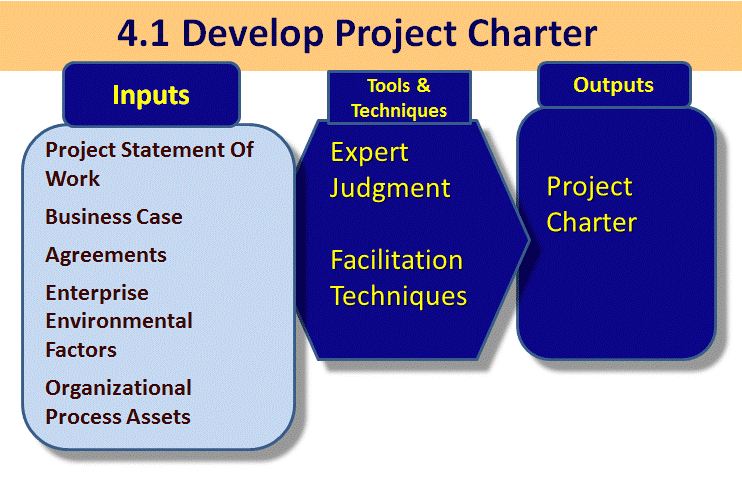
Project Management Institute, A Guide to the Project Management Body of Knowledge, (PMBOK® – Fifth Edition, Project Management Institute Inc., 2013 Figure 4-2 Page 66 Guide)
The Big Picture
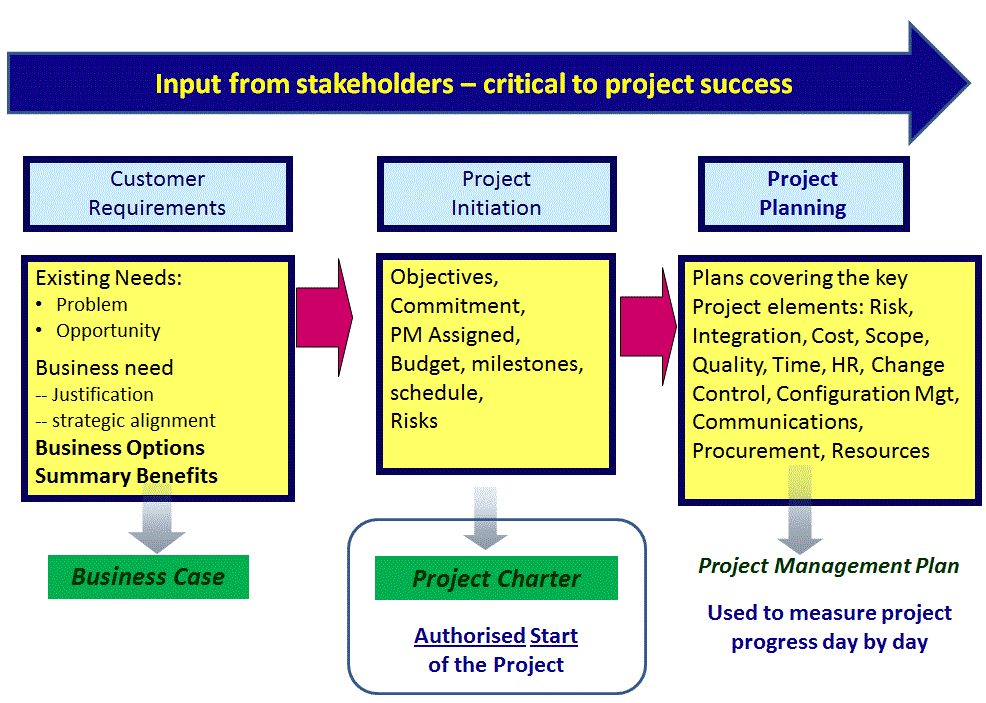
A Project Charter:
- Formally authorizes a project or a phase
- Documents initial requirements that satisfy the stakeholder’s needs and expectations
- Assigns the PM to the Project
- Benefits include a clear definition; a formal record; a record of senior managers committing to the project
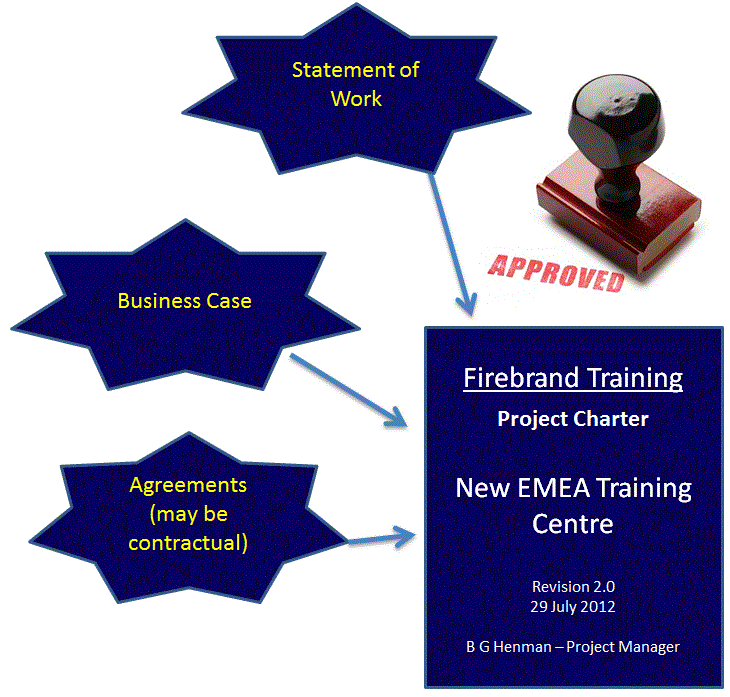
Input: Project Statement of Work (SOW)
- States or references the business need
- Can be progressively elaborated
- Product Scope Description - Documents the characteristics of the end product, service or result
- Strategic Plan – Vision, Goals, Objectives Strategic Alignment
- The Project SOW:
- Develops into the Project Charter and Project Scope Statement
- Is different to the Procurement SOW
Input: Business Case
- Justification for the investment in the Project Contents typically:
- Executive Summary
- Problem/Opportunity
- Reasons/Business Need
- Business Options
- Benefits (tangible and intangible)
- Success Criteria
- Key Risks
- Project Costs &Time
- Investment Appraisal
- Major Milestones
- Cost Benefit Analysis
- Investment Appraisal also called the Finance Case
- Presents the value this project will bring
- How viable it is and is used to help in selecting this project
Input: Agreements
May be a:
- Contract
- Service level agreement
- Letter of intent
- Letter of Agreement
- others
Project Selection Methods
- Payback Period – Breakeven Point
- = Cash outlay (investments)/Cash inflows
- (The time needed to recuperate your investment)
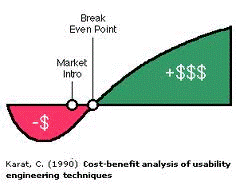
Opportunity Cost:
If Project “A” has NPV of $45K, Project “B” has NPV of $75K, what is the Opportunity Cost of selecting Project “B” (i.e. not selecting Project A)?
Eg. A family might decide to use a short period of vacation time to visit Disneyland rather than doing household renovations.
The opportunity cost of having happier children could therefore be (not having) a remodelled bathroom.
Benefits : Cost Ratio
- >1 is good where as <1 is bad
- if benefits : cost ratio = 1:1, there would have to be other reasons to select the project
- Benefits : Cost sounds more positive than Cost : Benefits
Working out BCR
You invest $100 and get back $120 then your BCR =
- Total Revenue (Benefit) : Cost
- in this case, BCR = (120:100) = 1.2 : 1 , the BCR is higher than 1 so is good.
Payback Period – Example
Project Cost £100,000
Project timescale 6 months
Maintenance costs £6000/year
Benefits £100,000 per year
|
Year 1 |
Year 2 |
Year 3 |
Year 4 |
Year 5 |
|
Project costs |
£100,000 |
£0 |
£0 |
£0 |
£0 |
Maintenance costs |
£3,000 |
£6,000 |
£6,000 |
£6,000 |
£6,000 |
Benefits |
£50,000 |
£100,000 |
£100,000 |
£100,000 |
£100,000 |
Net |
-£53,000 |
£94,000 |
£94,000 |
£94,000 |
£94,000 |
Cum. Net |
-£53,000 |
£41,000 |
£135,000 |
£229,000 |
£323,000 |
Time to accrue £53,000 in year 2 = £53,000 * 12 months/94,00 = 7 months
Payback period = 1 year 7 months
Return on Investment
= (average annual profit/original investment) * 100%
Average annual profit = total profit/number of years
If Project cost is £100k:
- Benefits are £50k year 1, then £100k/year for 4 years
- Average annual profit = (450k – 100k) / 5 = £70k
- ROI = (70k/100k) * 100% = 70%
The Board would bite your hand off if presented with this project!!
Discounted Cash Flow (DCF)
- Enables the analysis of future net cash flows discounted back "at an appropriate interest rate" into present value terms
- Assumes that the cash inflows are reinvested at the cost of capital
- Relies on a discount rate
- The discount rate is the interest rate used to evaluate the project and is sometimes referred to as the cost of capital, hurdle rate, cut off rate and required rate of return
- For more information read - http://www.elsevierdirect.com/ companions /9780127408521/exercises/191to214.pdf
- Three techniques use DCF
- Discounted Payback
- Net Present Value (NPV)
- Internal Rate of Return (IRR)
It's unlikely to be a requirement to carry out these calculations in the PMP ® exam. But you do need to be able to interpret / understand the above.
Discounted Cash Flow and Present Value
- Money in the company should be used to maximum effect
- If left in a bank and the interest rate were 10%, then:
- Year 1 end – $1,000 would be $1,100
- Year 2 end – $1,210
- Year 3 end – $1,331, etc… ($1610 in Y5)
Present Value
also known as discounting, is the reverse effect.
- It sees that $1,331 in 3 years time is worth $1,000 now
This money invested into the project has to take into account the effect of “e.g. inflation of 10%”
- Year 1 end – $1,000 would be $909 (1000 / 1100 = 0.909)
- Year 2 end - $826.40
- Year 3 end - $751.30, etc… ($620 in Y5)
Present Value and Future Value
Using the formulae
- Future Value (FV) = PV (1 + i)ⁿ
- Present Value (PV) = FV/(1 + i)ⁿ
i=interest rate; n= number of time periods
- Present Value is always less than the equivalent Future Value
- Example – What is the Future Value of $21,500 invested at 8% in 3 years time?
Calculation: $21,500 x (1.08 x 1.08 x 1.08 (=1.26)) = $27,084
Net Present Value
This is the total of the discounted cash flows, in and out, over the life of the project. It allows you to calculate an accurate value for the project in today’s £££
- Always choose the project with the greatest NPV
Example of NPV:
Year |
Total Cost |
Revenue or Benefits |
Net Cash Flow |
Discounted Factor 10% |
Discounted Cash Flow |
|
0 |
£900,000 |
0 |
-£900,000 |
1 |
-£900,000 |
|
1 |
£80,000 |
£80,000 |
0.909 |
£72,727 |
|
|
2 |
£160,000 |
£160,000 |
0.826 |
£132,231 |
|
|
3 |
£280,000 |
£280,000 |
0.751 |
£210,368 |
|
|
4 |
£420,000 |
£420,000 |
0.683 |
£286,866 |
|
|
5 |
£560,000 |
£560,000 |
0.621 |
£347,716 |
|
|
6 |
£680,000 |
£680,000 |
0.564 |
£383,842 |
|
Totals |
£2,180,000 |
NPV £533,750 |
IRR: Internal Rate of Return
Sometimes called DCF Yield or DCF Return On Investment
- IRR is the value of the discount rate (%) when the NPV is zero
- or, The break-even rate of return
- INVEST if IRR is greater than the cost of capital or threshold discount rate.
- Always choose the project with the highest IRR
Decision Models
Decision Trees: Define all the possible outcomes, the probability of each, and its value. Choose the best alternative.
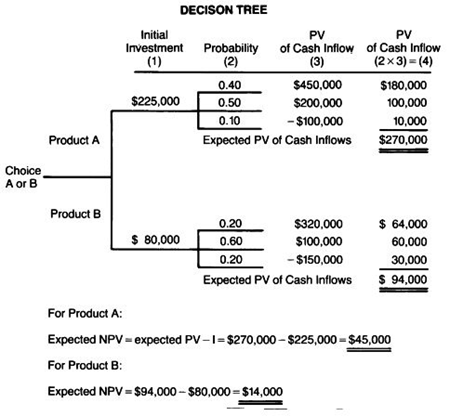
Forced Choice: Decision makers choose among alternatives, selecting the one preferred and discarding the rest.

Weighted Scoring
Takes multiple selection criteria into account
Important to inform sellers of these criteria
Removes personal bias, is more objective, and considers relative importance of different evaluation factors
- Determine the evaluation factors
- Assign a numerical weight to each factor
- Inform potential sellers
- Receive submissions
- Rate the projects on each criterion
- Multiply each rating by its weight
- Total the weighted ratings
- Select project with the highest number
Evaluation criteria and weight factors:
Example criteria: |
Weight factor |
Payback period (in years) |
20% |
IRR (in percentage) |
40% |
Number of specialists and range of expertise |
10% |
Innovative (yes, No) |
10% (yes = 10%, No = 0%) |
Quality and reliability of solution |
20% |
Other Terms – Selection Criteria
Working Capital - How much money the company can invest
Depreciation
- Straight line same amount every year until 0
- Accelerated
- Double declining balance
- applying the same percentage depreciation each year to the amount to be depreciated.
- e.g. for a project laptop costing $1500 and a residual value of $300, the amount to be depreciated is $1200.
- in Y1 depreciation = 1200 * 67% = 804; Y2 depreciation = 804 * 67% = $539, etc…
- Sum of the Years Digits
- if the cost was $50000, then depreciation over a 5 year period is $16.67k in year 1 (=50k/(1+2+3+4+5/5)
Sunk Costs
Law of Diminishing Returns
Tools and Techniques
Expert Judgement:
- Own experience based
- Other experts (SMEs) as required
Facilitation Techniques:
- Use facilitators when there are
- Contentious Issues
- Problems or conflicts
- When you need formal meetings with management
Output: Project Charter - Typical contents
- Business and Customer's Needs
- Assumptions and Constraints
- Purpose or justification (Business Case)
- Objectives and related success criteria
- High Level Requirements
- High level Project Description and boundaries
- High level Risks
- Summary milestone schedule
- Summary budget Stakeholders
- Project Approval Requirements
- Project Manager, responsibilitie and authority level
- Details of the Project Sponsor
Project Management Institute, A Guide to the Project Management Body of Knowledge, (PMBOK® – Fifth Edition, Project Management Institute Inc., 2013 Page 72 Guide)
Example of a Project Charter – New Nairobi Training Centre
Business Case – Customer contract and provide base to secure new business in EMEA
Objective: To set up a New Training Centre in Nairobi, to be operational within 9 months, at a cost not to exceed 3 million Euros
High Level Deliverables:
- Site Identified, survey carried out, permissions obtained
- Foundations and Drainage Laid, shell produced, 3 floors started
- Interiors first fit, internals completed, second fit, roof completed
- Furniture and equipment installed, opening held.
Out of scope: Fourth and fifth floors; Backup power generator
Risks: There may be delays in getting permissions to start the build; may be a lack of suitable local resource which could lead to extra cost through obtaining external resource
Assumptions: Firebrand's Operations Director will be available to hold talks with the local Government Ministers at the required times in months 2, 3 and 6.
Approval Requirements: Project Sponsor will approve the WBS before planning continues
Key Stakeholders: Government Ministers, Chief of Police, Local Magistrate, Firebrand SMT
Project Sponsor: A Barlow, Global Operations Director
Project Manager: B G Henman, PMP
The above example is very much summarised. In reality far more extensive text.
DISCLAIMER
Firebrand Training grants you a personal, non-exclusive, non-transferable license to access and use the site. You may download or print material from the site only for your own personal, non-commercial use. Read our full terms and conditions on https://firebrand.training/dk/learn/terms-and-conditions.
 Part of the BPP Education Group
Part of the BPP Education Group